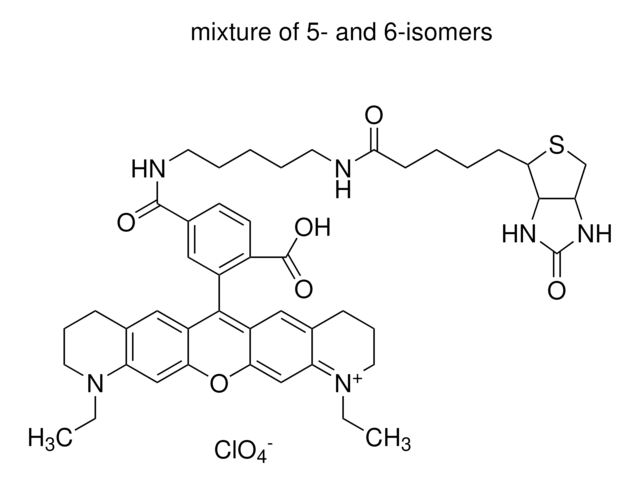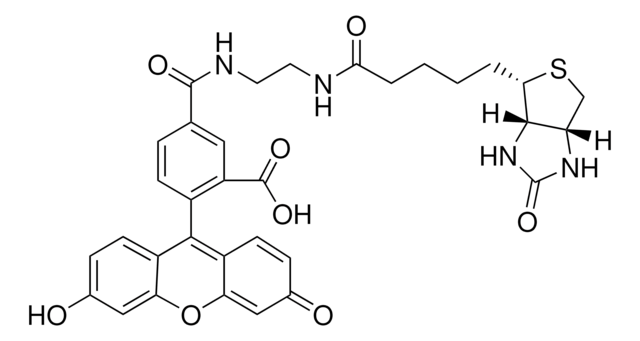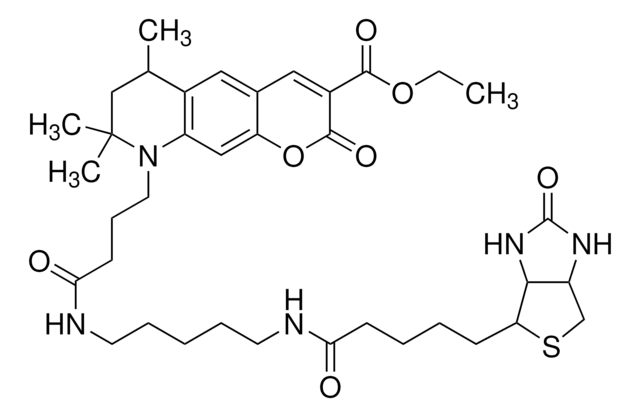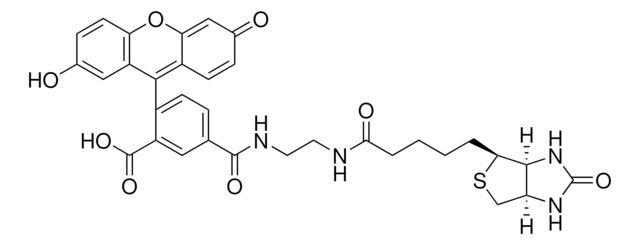Alle Fotos(1)
Wichtige Dokumente
06966
Atto 655-Biotin
BioReagent, suitable for fluorescence, ≥90% (HPCE)
Synonym(e):
Biotin-Atto 655
Anmeldenzur Ansicht organisationsspezifischer und vertraglich vereinbarter Preise
Alle Fotos(1)
About This Item
UNSPSC-Code:
12352116
NACRES:
NA.32
Empfohlene Produkte
Produktlinie
BioReagent
Assay
≥90% (HPCE)
Form
powder
Hersteller/Markenname
ATTO-TEC GmbH
Durchlässigkeit
254 nm
655 nm
Löslichkeit
DMF: soluble
DMSO: soluble
acetonitrile: soluble
Fluoreszenz
λex 655 nm; λem 680 nm in 0.1 M phosphate pH 7.0
λ
in ethanol (with 0.1% trifluoroacetic acid: 655 nm ± 3 nm)
Eignung
suitable for fluorescence
Lagertemp.
−20°C
Anwendung
Atto 655 conjugated to biotin is useful for binding to proteins (i.e., avidin and streptavidin). The fluorescent properties include excellent thermal and photo-stability, high quantum yield, strong absorption (663 nm) and fluorescence (684 nm), and low triplet formation. It is a zwitterionic dye, carrying a net electrical charge of zero. Electron donors such as guanine and tryptophan can easily quench the fluorescence of this fluorophore. Biotin conjugated with ATTO 655 was applied to assess efficiency of BSA/avidin structures bound to a surface.
Rechtliche Hinweise
This product is for Research use only. In case of intended commercialization, please contact the IP-holder (ATTO-TEC GmbH, Germany) for licensing.
Lagerklassenschlüssel
11 - Combustible Solids
WGK
WGK 3
Flammpunkt (°F)
Not applicable
Flammpunkt (°C)
Not applicable
Persönliche Schutzausrüstung
Eyeshields, Gloves, type N95 (US)
Hier finden Sie alle aktuellen Versionen:
Besitzen Sie dieses Produkt bereits?
In der Dokumentenbibliothek finden Sie die Dokumentation zu den Produkten, die Sie kürzlich erworben haben.
Kunden haben sich ebenfalls angesehen
Bengang Xing et al.
Chemistry (Weinheim an der Bergstrasse, Germany), 17(50), 14170-14177 (2011-11-16)
The molecular interactions of the glycopeptide antibiotic vancomycin (Van) with bacterial cell wall analogues N,N'-diacetyl-L-Lys-D-Ala-D-Ala (Ac(2) KdAdA) and N,N'-diacetyl-L-Lys-D-Ala-D-Lac (Ac(2) KdAdL) were investigated in neat water, phosphate buffer and HEPES buffer by using fluorescence correlation spectroscopy (FCS) and molecular dynamics
Ruixue Zhu et al.
The journal of physical chemistry. B, 115(17), 5001-5007 (2011-04-12)
Atto655 has been widely used as an excellent probing dye through photoinduced electron transfer (PET) for biochemical processes in oligonucleotides or polypeptides. However, its photophysical properties in the presence of the quenchers guanosine and tryptophan have not been carefully studied.
Eilon Sherman et al.
Chemphyschem : a European journal of chemical physics and physical chemistry, 12(3), 696-703 (2011-01-29)
Intramolecular dynamics in the denatured state of a protein are of importance for protein folding. Native-like contact formation within the ensemble of denatured conformations of a protein may guide its transformation towards the native conformation. The efficiency of folding is
Achim Friedrich et al.
FEBS letters, 581(8), 1644-1648 (2007-04-03)
This article presents a new, highly sensitive method for the identification of single nucleotide polymorphisms (SNPs) in homogeneous solutions using fluorescently labeled hairpin-structured oligonucleotides (smart probes) and fluorescence single-molecule spectroscopy. While the hairpin probe is closed, fluorescence intensity is quenched
Søren Preus et al.
Chembiochem : a European journal of chemical biology, 13(14), 1990-2001 (2012-09-01)
Förster resonance energy transfer (FRET) is a powerful tool for monitoring molecular distances and interactions at the nanoscale level. The strong dependence of transfer efficiency on probe separation makes FRET perfectly suited for "on/off" experiments. To use FRET to obtain
Unser Team von Wissenschaftlern verfügt über Erfahrung in allen Forschungsbereichen einschließlich Life Science, Materialwissenschaften, chemischer Synthese, Chromatographie, Analytik und vielen mehr..
Setzen Sie sich mit dem technischen Dienst in Verbindung.




